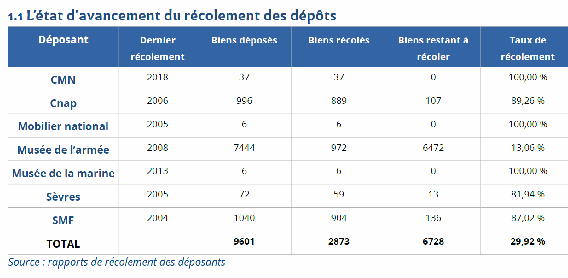
Make the change!
The Ministry of Culture and Communication published in April 2019 the summary of the collection assessment of cultural property deposits for the department of Bouches-du-Rhône.
The harvesting rate does not reach 30%!
“Created in 1996, the commission for works of art inventory (CRDOA), placed with the Minister of Culture, is responsible for piloting the operations for the inventory of deposits of state cultural property.”
“The check is not limited to a simple check of the physical presence of the object, but consists in carrying out a complete photographic campaign of the property, with indication of its location, its condition, its marking, the conformity of the inscription to the inventory.
To facilitate the harvesting operations, and if necessary to report disappearances between two inventories, the depositaries are required to provide each year to each depositor concerned a statement of the deposits from which they benefit, including the indication of their location and their condition. conservation. However, this obligation is not respected.”

Despite the clearly stated obligations, the available literature on the subject and the will of the teams, proofing remains problematic depending on the material and human resources in place as well as the time allotted.
In the end, the expected result is unfortunately not there.
There is also the problem of identifying and locating works whether they are exhibited, loaned or stored in reserves.

Digital tools (RFID) to help collection assessment and inventory
Some cultural establishments use paper, others spreadsheet software, some collections management software (CMS) few have digital barcode systems.
What they have in common is the complexity of those tools, the time required to train and use these tools and of course the lack of budget to deploy something else.
#RFID Radio Frequency Identification technology identifies works whether or not they are exhibited.
It compensates for all the constraints of barcode systems (reduced number of stored information, no update possible on this information, reading of the binding label) and represents a real asset for proofing missions.
The advantage of RFID also lies in the use of international norms and standards. Thus the equipment purchased (readers, terminals, etc.) can be shared and compatible from one establishment to another (practical for monitoring loan movements!).
Feedback: The Marseille Museum of History collections site with the EDITAG Arts RFID solution (formerly monalitag®).
SERVICES PROVIDED:
- Ensure the transfer of collections;
- List the interventions (condition reports) for the most urgent restoration operations;
- Have a complete, correct and up-to-date inventory for the traceability of each object in the collection.
ADVANTAGES :
- Easy to learn and use;
- Centralized and saved server;
- Fast, the site was completed in the allotted time;
- Effective.
Assessment of the collection assesment: 39,351 objects – 3 months – Budget respected.
If you would like more information on digital tools for museum development or more broadly on new technologies to identify and locate works of art: contact EDITAG, we will be happy to share our experience on the subject.


